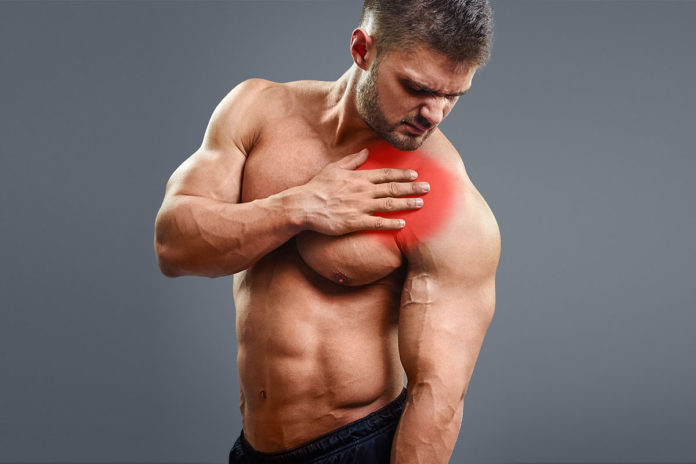HEALTH & WELLNESS
Why Muscles Get Sore
As people age, they begin to complain more of pains in their muscles and joints. They seem to stiffen up with age, and such commonplace activities as bending over for the morning paper can make them wince.
Published
5 years agoon
By
fitinstyle
As people age, they begin to complain more of pains in their muscles and joints. They seem to stiffen up with age, and such commonplace activities as bending over for the morning paper can make them wince.
Such pain can grip so fiercely that they are sure it begins deep in their bones. But the real cause of stiffness and soreness lies not in the joints or bones, according to research at the Johns Hopkins Medical School, but in the muscles and connective tissues that move the joints.
The frictional resistance generated by the two rubbing surfaces of bones in the joints is negligible. Even in joints damaged by arthritis.
Flexibility
The medical term used to describe the range of a joint’s motion from full movement in one direction to full movement in the other is flexibility. The greater the range of movement, the more flexible the joint.
If you bend forward at the hips and touch your toes with your fingertips, you have good flexibility, or range of motion of the hip joints. But can you bend over easily with a minimal expenditure of energy and force? The exertion required to flex a joint is just as important as its range of possible motion.
Motion Range
Different factors limit the flexibility and ease of movement in different joints and muscles. In the elbow and knee, the bony structure itself sets a definite limit. In other joints, such as the ankle, hip, and back, the soft tissue muscle and connective tissue limit the motion range.
The problem of inflexible joints and muscles is similar to the difficulty of opening and closing a gate because of a rarely used and rusty hinge that has become balky.
Hence, if people do not regularly move their muscles and joints through their full ranges of motion, they lose some of their potential. That is why when these people will try to move a joint after a long period of inactivity, they feel pain, and that discourages further use.
What happens next is that the muscles become shortened with prolonged disuse and produces spasms and cramps that can be irritating and extremely painful. The immobilization of muscles, as researchers have demonstrated with laboratory animals, brings about biochemical changes in the tissue.
However, other factors trigger sore muscles. Here are some of them:
1. Too much exercise
Have you always believed on the saying, “No pain, no gain?” If you do, then, it is not so surprising if you have already experienced sore muscles.
The problem with most people is that they exercise too much. Thinking that it is the fastest and the surest way to lose weight. Until they ache, they tend to ignore their muscles and connective tissue, even though they are what quite literally holds the body together.
2. Aging and inactivity
Connective tissue binds muscle to bone by tendons, binds bone to bone by ligaments, and covers and unites muscles with sheaths called fasciae. With age, the tendons, ligaments, and fasciae become less extensible. The tendons, with their densely packed fibers, are the most difficult to stretch. The easiest are the fasciae. But if they are not stretched to improve joint mobility, the fasciae shorten. This places undue pressure on the nerve pathways in the muscle fasciae. Many aches and pains are the result of nerve impulses traveling along these pressured pathways.
3. Immobility
Sore muscles or muscle pain can be excruciating, owing to the body’s reaction to a cramp or ache. In this reaction, called the splinting reflex, the body automatically immobilizes a sore muscle by making it contract. Thus, a sore muscle can set off a vicious cycle pain.
First, an unused muscle becomes sore from exercise or being held in an unusual position. The body then responds with the splinting reflex, shortening the connective tissue around the muscle. This cause more pain, and eventually the whole area is aching. One of the most common sites for this problem is the lower back.
4. Spasm theory
In the physiology laboratory at the University of Southern California, some people have set out to learn more about this cycle of pain.
Using some device, they measured electrical activity in the muscles. The researchers knew that normal, well-relaxed muscles produce no electrical activity. Whereas, muscles that are not fully relaxed show considerable activity.
In one experiment, the researchers measured these electrical signals in the muscles of persons with athletic injuries. First with the muscle immobilized, and then, after the muscle had been stretched.
In almost every case, exercises that stretched or lengthened the muscle diminished electrical activity and relieved pain, either totally or partially.
These experiments led to the “spasm theory,” an explanation of the development and persistence of muscle pain in the absence of any obvious cause, such as traumatic injury.
According to this theory, a muscle that is overworked or used in a strange position becomes fatigued. And as a result, sore muscles.
Hence, it is extremely important to know the limitations and capacity of the muscles in order to avoid sore muscles. This goes to show that there is no truth in the saying, “No pain, no gain.”
What matters most is on how people stay fit by exercising regularly at a normal range than once rarely but on a rigid routine.
You may like
HEALTH & WELLNESS
5 Skincare Regimens Perfect for Spring and Summer
Published
3 months agoon
February 21, 2024By
fitinstyle
Spring is in the air! The trees are changing colours, flowers are blooming, and you will notice that your skin feels different too. The sun is getting harsher, and heat and humidity will make their way towards hampering the skin… Well, if you don’t care. If you fail to switch from your heavy winter skincare routine to a light spring one, you could soon be facing the issues of acne, breakouts and dull skin.
This is the perfect time to amp up your skincare and go in for dermatological treatments like chemical peels and laser skin resurfacing. You can also help your skin be spring and summer-ready by using the right skincare ingredients. An intelligent combination of active ingredients can do wonders for the skin and even keep the signs of ageing away. To make the most of the spring weather learn to make the most of your skincare routine.

Best skincare combinations that will work for your skin
The important thing to remember is to pair your skincare ingredients correctly together. Very few are power couples for the skin that might work and benefits your skin. The first trick, of course, is to not use all the products together. To maximise the benefits of the skincare ingredients, here are some important parings you should not miss:
1. Vitamin C with SPF
Vitamin C is an essential ingredient for skin care. It helps protect the skin from sun damage, fights the antioxidants, repairs the skin barrier, promotes collagen production, and acts as an anti-ageing ingredient. When combined with sunscreen, the two work to protect your skin from environmental damage and block the UV rays that filter through the sunscreen.
Also Read: Vitamin C for skin: 7 benefits you must know about
2. Niacinamide with salicylic acid
Niacinamide is an important ingredient for fortifying the skin barrier and treating hyperpigmentation. Salicylic acid is what your skin needs to keep the breakouts away. When they are used together, your skin will benefit from reduced pore size, prevent acne breakouts, improve skin strength and work against the signs of ageing. Together they also improve collagen and elastin fibres giving the skin a youthful glow from the inside.

3. Retinols with peptides
Move the retinol to your nighttime routine during this time of the year. Vitamin A derivatives are the gold standard for home skin care because they treat everything from acne to ageing to fine lines. Peptides help skin cells rejuvenate and repair. Together they correct your complexion, make the skin tighter and give a smoother and plumper look to the skin.
4. Vitamin C and vitamin E
Vitamin C is essential for skin rejuvenation and protection, and vitamin E helps keep the skin supple. You can use them together to protect the skin from oxidative stress and maintain the suppleness of the skin, leaving you to enjoy the weather in its full glory.
5. Hyaluronic acid with exfoliating acids
Spring is a good time for skin repair, and the AHAs and BHAs do a great job of removing the top layer of the skin, making the new skin sensitive to dryness, and hyaluronic acid is a humectant that restores dryness. Hyaluronic acid recharges skin hydration and has long-lasting benefits for the skin.

Things to remember
When using new skin combinations, make sure you take your skin type into account. Always do a patch test first and start when using these combinations 1-2 times a week along with your regular skincare routine and slowly increase the frequency as needed by the skin. Do not over-exfoliate or scrub the skin, focus on good skin care every day for great results instead.

The sports supplements industry is one of the largest industries in the world of sports, especially with respect to revenue. Athletes are often attracted to these supplements by the effective marketing approaches used by marketers to sell these products. In sports, every athlete seeks to stage the best performances to achieve different milestones through their sporting life. The availability of supplements that can enhance the performance of these athletes makes them seductively attractive for these individuals. No one would miss an opportunity to improve their performance, irrespective of the risks that exist. However, there is a need to ensure that these supplements are regulated. The lack of regulations in the sports supplement industry could lead to increased risks for the athletes. Perhaps we need to have a more standard approach to the management of sports supplements.
By Gabriel I. Escalera
First, it’s essential to first have a better understanding of what sports supplements are in the sporting industry. Sports supplements are additional nutrients that individuals can add to their normal diets to improve their physical abilities to perform in physical activities. Active athletes often include supplements in their diets to achieve sufficient nutrition for optimal performance in sports. In addition, athletes also use supplements to compensate for nutritional deficiencies. Most importantly, there is a belief among athletes that supplements significantly improve their abilities, helping them achieve higher performance.
Supplements play an important role in the diets of athletes. As the name suggests, these substances should be used in addition to the normal diet, as opposed to being replacements. There are supplements that have been developed based on scientific evidence. This means that there are supplements in the market that can be beneficial to the athletes who consume them. There are several benefits that athletes can draw from using these supplements. One of the most significant benefits is that they can legally improve the performance of athletes. Other than that, supplements can also be used to attain the required weight for a specific sport’s weight classes. Similarly, they can be effective in losing weight for a specific sport. Supplements can also be used by athletes to build muscles and improve the circulation of oxygen within the body. Moreover, supplements also provide athletes with an option that helps them avoid the temptations of using other performance-enhancing drugs that are banned in most competitive sporting activities. As such, supplements are critical for athletes, especially with respect to the possibility of enhancing performances.
There is a significant difference between performance-enhancing drugs and dietary supplements. There is a complete ban on performance enhancing drugs in the sporting world. However, dietary supplements are allowed within the sporting world. In the United States, the Food and Drug Administration (FDA) does not place strict regulations on sports supplements. So, the manufacturers of these substances are not required to submit samples of their products to the FDA. The only requirement for sport supplement manufacturers is to make a claim of the health benefits of the supplement, based on scientific evidence. However, the FDA does not go beyond that to scientifically verify these claims. Because of this there may be inadequate regulation of sports supplements, and this places the athlete at the risk of consuming substances that may be harmful to them.
The use of supplements has continued to be a controversial topic among the stakeholders in the supplement industry. These controversies tend to keep the conversation going and ensure that we can develop policies and laws that regulate the production and use of sports supplements. There are concerns about the processes involved in the manufacture of some sports supplements. The manufacturing process plays a significant role in determining the final product. The manufacturing process involves the use of different ingredients and processes that are not entirely known or understood.
Another important area of concern over sports supplements is that of the quality of these supplements. The quality of the supplement is critical however, the FDA does not require any quality standards on supplements. The FDA only requires that the manufacturers make a claim about the health benefits of these supplements. The FDA does not require the manufacturer to provide clinical or scientific trial results that verify the claims. This means that the manufacturers have considerable leeway to provide inaccurate information about the supplements to get approval from the FDA. It is also possible that the manufacturers could create the same substance, give it a different name, and different claims to ensure that they are seen as different supplements.
Based on these observations, there appears to be a need to develop programs, policies, and laws that effectively regulate the production and sale of sports supplements. There is a need for the stakeholders, especially the FDA, to change the approach to the management of the supplements in the market. Regulations should be developed to streamline the manufacturing process. Just like in the manufacture of medicines, there seems to be a need to regulate the manufacture of sports supplements. These supplements, when ingested, have the capacity to alter the body’s function. Their effects are similar to medicines. The regulation of the manufacturing process would ensure that there is a standard quality for every type of supplement. It could ensure that the most appropriate ingredients and processes are used in their manufacture.
Quality control measures should also be implemented to ensure that the supplements are not harmful. The quality of the supplements is dependent on scientific validation of their effectiveness in achieving the objectives for which they are created. As such, the FDA should implement programs that would compel the manufacturers to provide scientific verification for the health claims made. This would mean that quality is central to the development and production of the sports supplements. As such, it could provide a regulatory framework established to eliminate the safety risks associated with sports supplements. This way, sports supplements will be able to achieve their fundamental objectives without creating any controversy.
References
Kapoor, A., & Sharfstein, J. M. (2016). Breaking the gridlock: Regulation of dietary supplements in the United States. Drug testing and analysis, 8(3-4), 424-430. Maughan, R. J., Burke, L. M., Dvorak, J., Larson-Meyer, D. E., Peeling, P., Phillips, S. M., … & Meeusen, R. (2018). IOC consensus statement: dietary supplements and the high-performance athlete. International journal of sport nutrition and exercise metabolism, 28(2), 104-125.

When it comes to achieving a desirable body, it is common for people to have problem areas such as love handles, flabby arms, sagging skin, or hips. The market is flooded with products that claim to eliminate fat or tone specific body parts, from creams and applications to gadgets and machines. However, the reality is that you cannot spot reduce, and the attempt to do so is not only futile but also potentially harmful.
There are several reasons why spot reduction is a myth. Firstly, a healthy diet is crucial in eliminating body fat, and consuming high-calorie and high-cholesterol foods can cause the accumulation of fat in problem areas. No matter how many gadgets you use, if you continue to indulge in unhealthy foods, you will not see results.
Secondly, spot reduction is a simplistic approach that overlooks the complexity of the body. Many products claim to require nothing but attaching or applying them to problem areas, neglecting other body parts and requirements. To achieve a healthy body, you need to understand the physiology of your body and what it takes to achieve your goals. For example, if you want six-pack abs, you need to focus not only on abdominal exercises but also on reducing body fat and increasing body mass through a healthy diet and cardio exercises.
Thirdly, there are no shortcuts to achieving a healthy body. Miracle diets, pills, and potions may seem like a quick fix, but they will ultimately lead to a dead end. To achieve a healthy body, you need to put in the work and earn it.
Finally, committing to the health of your body is a lifelong dedication. Even if you achieve a desirable body now, it will not remain so forever if you abuse your diet and lifestyle. Therefore, it is essential to develop a holistic approach to your health and fitness, incorporating not only exercise and diet but also a positive outlook on life.
In conclusion, the key to achieving a desirable body is to do it the proper way. There are no shortcuts or quick fixes, and spot reduction is a myth. Instead, focus on developing a healthy diet and exercise program that addresses the whole body, and commit to a lifelong dedication to your health and well-being. By taking matters into your own hands, you can enjoy the benefits of a healthy body and a positive outlook on life.
Recent Posts
- The Ultimate Guide to Berberine: Unlocking Its Health Benefits and Healing Properties
- The Ultimate Guide to Berberine: Unleashing its Health Benefits for Blood Sugar Control, Weight Management, and More
- The Ultimate Guide to Berberine: How This Natural Compound Can Revolutionize Your Health
- The Ultimate Guide to Berberine: Unlocking Its Powerful Health Benefits for a Healthier You
- Exploring the Health Benefits of Berberine: A Natural Remedy for Diabetes, Cholesterol, and More
Advertisement
Sponsored Ads
TRENDING
-

 HEALTH & WELLNESS5 years ago
HEALTH & WELLNESS5 years agoAcidophilus: A Probiotic Bacterium
-

 herbs3 months ago
herbs3 months agoThe Ultimate Guide to Ashwagandha Extract: Stress Relief and Optimal Health Unveiled
-

 HEALTH & WELLNESS4 years ago
HEALTH & WELLNESS4 years agoHerbs and Essential Oils to Fight Coronavirus
-

 TRAINING & FITNESS5 years ago
TRAINING & FITNESS5 years ago6 Ways to Decrease your Shoulder Pain!
-

 DIET & NUTRITION5 years ago
DIET & NUTRITION5 years agoLow Carb Diet: Carbohydrates Influence on Testosterone
-

 Fitness5 years ago
Fitness5 years ago“No Pain, No Gain” True or Just a Fitness Myth
-

 HEALTH & WELLNESS5 years ago
HEALTH & WELLNESS5 years agoThe Best Shoulder Workout in Only Six Moves
-

 HEALTH & WELLNESS5 years ago
HEALTH & WELLNESS5 years agoEnhancing Recovery with Creatine

